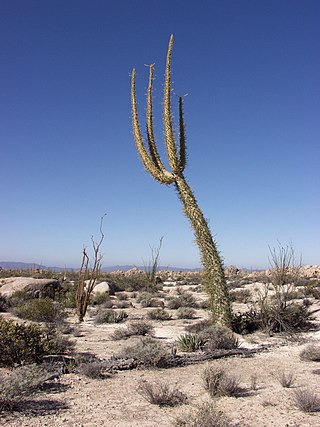
Fouquieria columnaris, the Boojum tree or cirio is a tree in the ocotillo family, whose other members include the ocotillos. Some taxonomists place it in the separate genus Idria. It is nearly endemic to the Baja California Peninsula, with only a small population in the Sierra Bacha of Sonora, Mexico. The plant's English name, Boojum, was given by Godfrey Sykes of the Desert Laboratory in Tucson, Arizona, and is taken from Lewis Carroll's poem "The Hunting of the Snark".

The Coronado Islands are a group of islands located 13 km (8 mi) off the northwest coast of the Mexican state of Baja California. Battered by the wind and waves, the rocky islands are mostly uninhabited except for a small military detachment and a lighthouse keeper. Despite their barren appearance, they serve as a refuge for seabirds and support a sizable number of plants, including 6 endemic taxa found only on the islands. The waters around the islands support a considerable amount of diverse marine life.

Dudleya, commonly known as liveforevers is a genus of rosette-forming succulent plants in the stonecrop family, Crassulaceae, consisting of about 68 taxa in southwestern North America and Guadalupe Island. The species come in many forms, with some large and evergreen, others geophytic and deciduous. Yet, despite their dramatic variations in appearance, most species readily hybridize. The flowers of Dudleya have parts numbered in fives, with the petals arranged in tubular, star-shaped, and bell-shaped forms and, when fruiting, are filled with tiny, ovoid-crescent-shaped seeds.

Bergerocactus emoryi is a species of cactus, known commonly as the golden-spined cereus, golden snake cactus, velvet cactus or golden club cactus. It is a relatively small cactus, but it can form dense thickets or colonies, with the dense yellow spines giving off a velvety appearance when backlit by the sun. From April to May, yellow, green-tinged flowers emerge, which transform into reddish, globular fruit. This species is native to the California Floristic Province, and is found in northwestern Baja California and a small part of California, in San Diego County and on the southern Channel Islands. Where the Mediterranean climate of the California Floristic Province collides with the subtropical Sonoran Desert near El Rosario, hybrids with two other species of cacti are found. It is the sole member of the monotypic genus Bergerocactus, named after German botanist Alwin Berger.

Malacothrix is a genus of plants in the tribe Cichorieae within the family Asteraceae. They are known generally as desert dandelions or desertdandelions. Most are native to western North America although a few have been introduced to South America. Several are found only on offshore islands in the Pacific.

Hazardia is a small genus of North American flowering plants in the family Asteraceae. Plants in this genus may be called bristleweeds or goldenbushes.

Bebbia, common name sweetbush, is a genus of aromatic shrubs in the family Asteraceae.

Euphorbia misera is a semi-succulent shrub in the genus Euphorbia commonly known as the cliff spurge or coast spurge. A drought-deciduous shrub, it is typically found as a gnarled, straggly plant occupying seashore bluffs, hills and deserts. Like other members of its genus, it has a milky sap, which can be found exuding out of the light gray bark when damaged. The alternately-arranged leaves are round and folded in the middle, with small hairs on them. The "flowers" can be found blooming year-round, and are colored maroon or yellow in the center with 5 white to light-yellow petal-like appendages attached outside. This species is native to the Baja California peninsula and Sonora in Mexico, and the coast of southern California in the United States, where it is a rare species. It is threatened in some localities by the development of its coastal habitat, which tends to be prime locations for high-end residential and commercial developments.

Deinandra is a genus of flowering plants in the tribe Madieae within the family Asteraceae. Such a genus is not recognized as distinct by all authorities; its species are often treated as members of the genus Hemizonia.
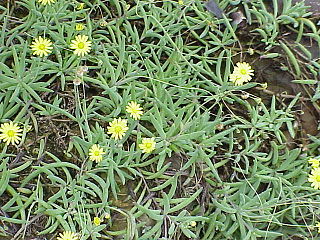
Crassothonna capensis, also known as little pickles (USA), ruby necklace (Australia), Cape aster, Cape Othonna, and Bobbejaankool (Afrikaans), is a species of the genus Crassothonna previously (Othonna) in the family Asteraceae, and is a native of the Eastern Cape of South Africa. It is a native highveld species that originates from the southern Drakensberg region.

Hofmeisteria is a genus of Mexican flowering plants in the family Asteraceae.
Alvordia is a genus of flowering plants in the family Asteraceae. It includes 4 species of shrubs which occur in the states of Baja California and Sonora, Mexico. The genus is characterized by having a secondary clustering of heads into compound units, so that what appears to be a single head is actually a group of heads packed together. The genus is classified as a member of subtribe Helianthinae, the same subtribe that contains the common sunflower (Helianthus). Based on the reported chromosome counts, Alvordia includes both diploid and polyploid species, but the relationships among these have not yet been studied in detail. No chromosome count has yet been reported for the species A. congesta from Sonora, which was a later transfer to the genus.

Gochnatia is a genus of flowering plants in the daisy family, Asteraceae. It is named for botanist Frédéric Karl Gochnat. The genus contains mainly shrubs and subshrubs, with a few trees and herbs. All of the species are native to the American tropics. Two species native to the mountains of Southeast Asia and formerly included here are now separated as the genus Leucomeris in subfamily Wunderlichioideae.
Baeriopsis is a monotypic genus of flowering plants in the family Asteraceae, containing the single species Baeriopsis guadalupensis. It is endemic to the Guadalupe Island archipelago along the coast of Baja California in Mexico. It grows in Guadalupe mesa scrub habitat.
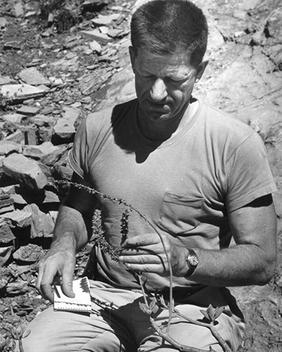
Reid Venable Moran was an American botanist and the curator of botany at the San Diego Natural History Museum from 1957 to 1982.
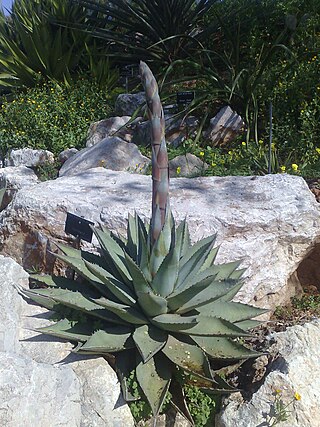
Agave margaritae is a species of plant from the Agave genus. Its common name in English is "Magdalena Island Agave".
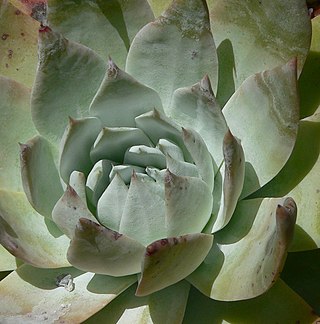
Dudleya anthonyi, known by the common name San Quintín liveforever, is a succulent plant endemic to the San Quintín volcanic field, located on Isla San Martín and the adjacent mainland bay of Bahia San Quintín, within Baja California.

Dudleya pachyphytum is an insular succulent plant known by the common name Cedros Island liveforever. It is a member of the genus Dudleya, in the family Crassulaceae. Characterized by thick, blunt leaves covered in a white, powdery wax and adorned by white flowers in bloom, it is regarded as one of the most attractive and charismatic members of its genus. It is endemic to the foggy northern end of Mexico's Cedros Island, occupying an ecological niche shared with the Cedros Island Pine.

Dudleya cochimiana, commonly known as the Cedros liveforever, is a species of succulent plant in the family Crassulaceae endemic to Cedros Island, a large island off of the coast of Baja California, Mexico. It is a rosette-forming leaf succulent characterized by broad, green to white leaves, and flowers with white to pink petals. It can be found on rocky slopes and canyons along the island.
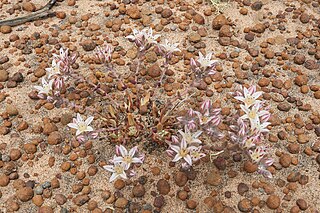
Dudleya crassifolia is a species of drought deciduous, corm-forming succulent plant known by common name as the thick-leaf dudleya. It is an incredibly rare and cryptic plant native to one small locale less than a hectare in area on the Colonet peninsula in Baja California. It is threatened by urban development, including a proposed seaport. It is characterized by white, spreading flowers with leaf bases that are persistent on the stem. Although it did not receive as much media attention as the neighboring Dudleya hendrixii, it has been noted that the plant has several similarities to cryptic succulents like Anacampseros.



















